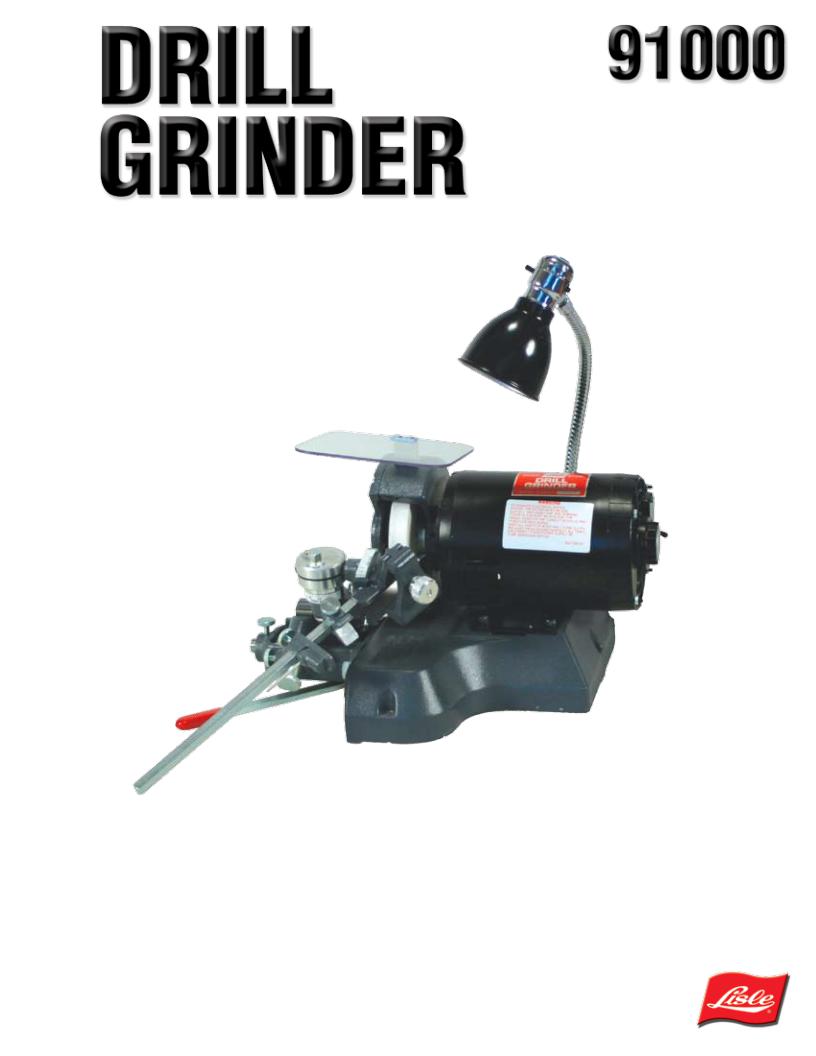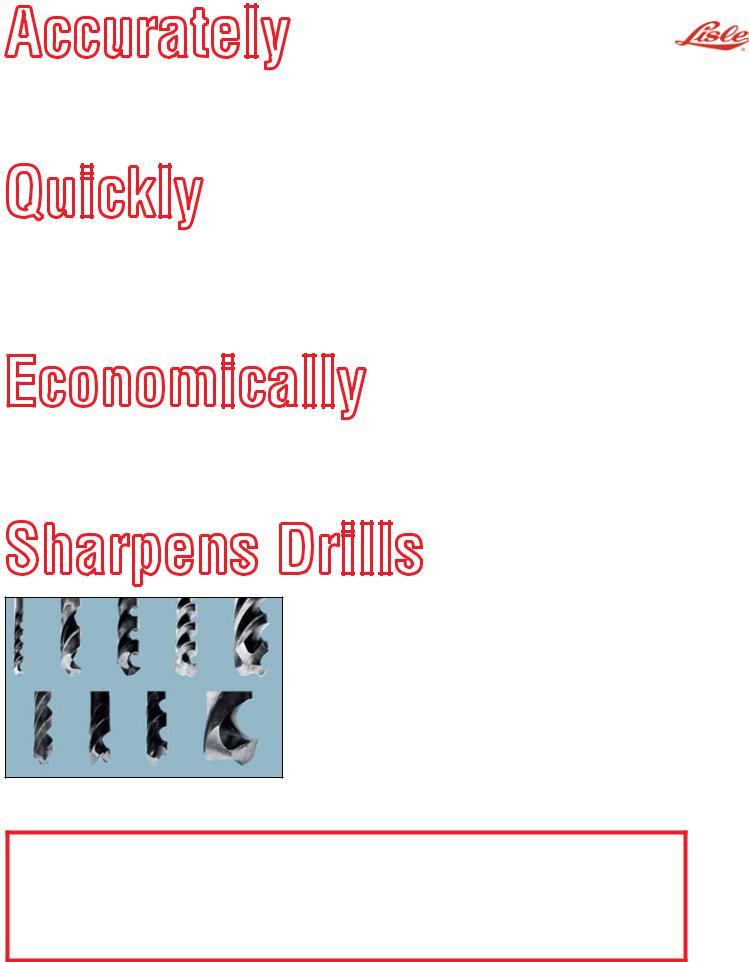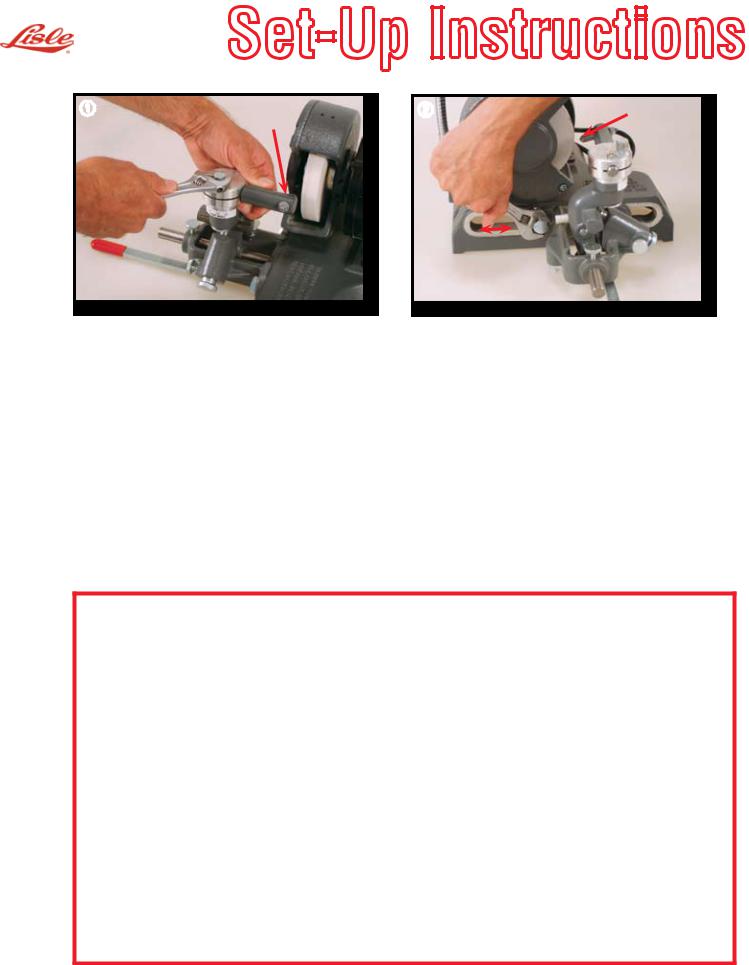Drill Grinder 91000 Instruction

Brochure Includes:
•Set-up Instructions
•Operating Instructions
•Parts List
•Fundamentals of Drill Sharpening
Patent 3,952,459

Accurately
Sharpens most drills bits.
Now, with this one low-cost, simple machine, several different types of drill bits can be quickly sharpened: two, three and four fluted drill bits, Flat Bottom and Core Drills. Precision work!
Quickly
With just a little experience, anyone can become an expert.
It takes only a few minutes to set up and have ready for operation this Lisle 91000 Drill Grinder. A few minutes reading ALL OF THE OPERATING INSTRUCTIONS will ensure the right start. A little practice and most every machine shop can be doing all its own sharpening the first day. Comes complete!
Economically
Without a major investment, every plant can own its own Drill Grinder.
The cost of commercial sharpening (to say nothing of the time it takes to get the work done commercially) plus the rapid increases in the cost of new bits makes owning and operating a Lisle 9100 Drill Grinder a practical, money-making investment.
Sharpens Drills
1 |
2 |
3 |
4 |
5 |
6 |
7 |
8 |
9 |
From 1/8" up to 1 1/4" in size.
The Lisle 9100 can handle drill bits as small as 1/8" up to and including 1 1/4". This machine will properly sharpen bits with straight or tapered shanks. Correct tolerances for heel clearance, chisel or web angle, and cutting lip angle are locked into position if properly set-up. Adjustments for various types and sizes of bits are quickly and easily made. No guess work or estimates.
1. 1/8" Standard Drill, 2. 1/4" Low helix Drill, 3. Standard 1/2" Drill, 4. 1/4" High helix Drill, 5. 4 Fluted Core Drill, 6. 3 Fluted Core Drill, 7. Flat Bottom Drill, 8. Standard 1/4" Drill, 9. 1 1/4" Standard 2 Fluted Drill.
The Lisle Drill Grinder 91000 is assembled at the factory to such an extent that it takes only minutes to set-up and be ready to operate. HOWEVER, it will pay to read through the set-up and operating instructions on a step by step basis prior to starting. This will help assure success on the first try and will also make the set-up easier and avoid the necessity of re-doing any work.
EACH PHOTOGRAPH IN THIS BROCHURE IS NUMBERED FOR QUICK REFERENCE TO SPECIFIC PROCEDURES, ASSEMBLIES, PARTS AND ADJUSTMENTS WHICH ARE MEANINGFUL TO BOTH SET-UP AND OPERATION.

Set-Up Instructions
q
Diamond
Dresser
A
w |
1/4" |
1.If possible, bolt Drill Grinder to left hand corner of work bench.
2.Install protective plastic shield with screws provided. Helps meet OSHA standards.
3.FOR FEED BRACKET ADJUSTMENT: (See photo 1) First, release the feed screw (A) until the rocker arm is in the full relaxed position. Align the marks on the diamond dresser and split bushing before tightening in place. Slide the feed bracket assembly (See photo 2) until the diamond is approxmately 1/4" from the stone. Tighten feed bracket in place.
4.TO DRESS THE GRINDING WHEEL: Plug motor into a three wire ground outlet and turn motor on. CAUTION! When dressing the stone or drill sharpening it is recommended that eye protection be
worn to prevent personal injury. Advance feed screw until the diamond just touches the grinding wheel. Loosen the cross-feed lock screw (See photo 14) and move the cross-feed lever to work the diamond back and forth across the grinding wheel.
NOTE: As the grinding wheel becomes unevenly worn from use, regular dressing will assure quality sharpening. Also, regular adjustment of the feed bracket to the reduced size of grinding wheel is a necessity. (See item 3)
If the grinding wheel housing becomes loose, tighten the two (X) set screws. (See Photo 3)
AFTER MASTERING SET-UP FOR STANDARD TWO FLUTED DRILLS, APPLY THESE VARIATIONS FOR OTHER TYPES DRILLS.
Sharpening Special Purpose Drills
(See Photo 13)
Flat Bottom (180 degree included Angle) -- First, split bushing should be set at 180 degrees (See operating instructions “I”). Loosen the two bolts holding the feed bracket and move it as far forward as possible. Position the drill in the drill holder as you would for grinding a standard drill point. Place the drill holder in the split bushing and advance the feed screw. As the drill approaches the stone, move the crossfeed lock screw. Grind the first lip in the normal manner. Set the stop sleeve, back up the feed screw, rotate the drill and grind the second lip.
Core Drill (3 Fluted) -- Position drill in holder with first lip parallel to the center line of the “V” of the drill holder. Do not use set-up line on stop lip for this grind. Move stop lip to margin of drill and tighten. Proceed to grind first lip as you would on a two fluted drill. Set the stop sleeve, back up the feed screw, rotate the drill and grind the second lip. Continue until all cutting lips have been ground.
Core Drill (4 Fluted) -- Position drill in holder with the first lip parallel to the center line of the “V” (same as 3 fluted) (See photo 9). Do not use set-up line on stop lip for this grind. Move stop lip to margin of drill and tighten. NOTE: The grinding procedure on this drill is different because of the closeness of the cutting lips. Place drill holder in split-bushing and position the holder so that the axis of the drill is at an angle of about 10 degrees below the horizontal (about 2" drop at the end of the drill holder shaft) before tightening in place (See photo 13). Advance the feed screw until first lip just touches the grinding stone. Then with quick motions, advance the feed screw slightly and back it off to avoid burning. This can best be done by rocking the feed screw back and forth. Continue until the first lip is ground, then quickly tighten the stop sleeve and back off the feed screw. Examine the clearance angle on the lip which was just sharpened. If the clearance angle looks acceptable, then proceed to grind the remaining lips in the same manner. If the clearance angle is not acceptable, then the angle of the drill with the horizontal will have to be changed. Decreasing the angle will decrease the clearance and increasing the angle will increase the clearance.
